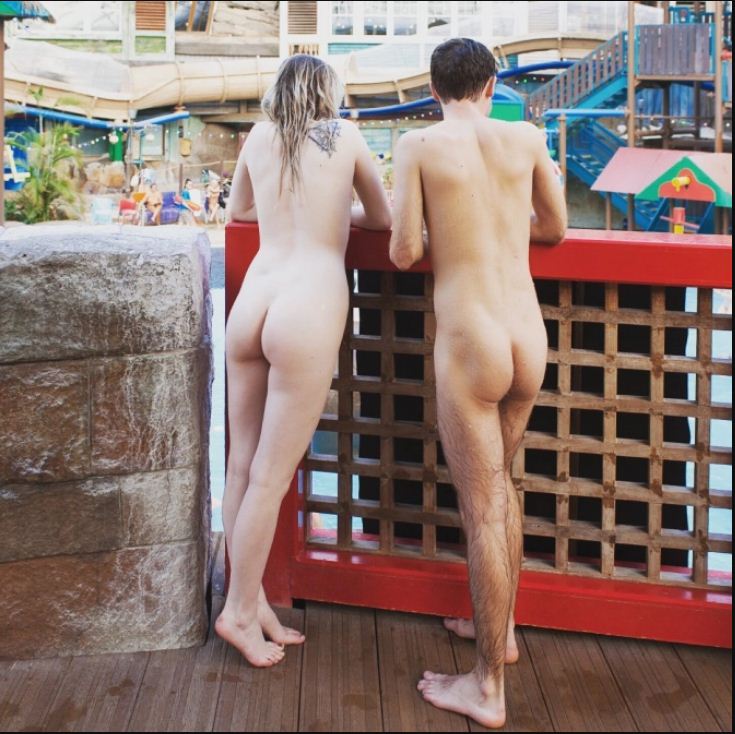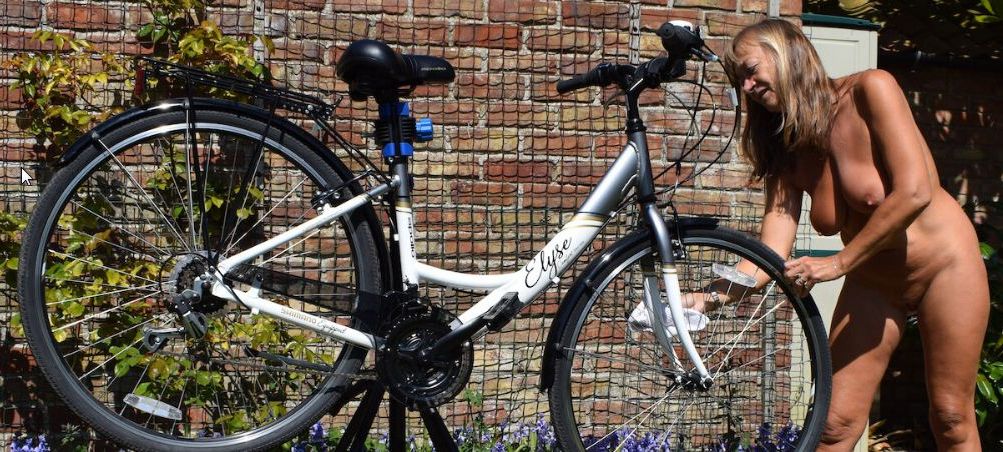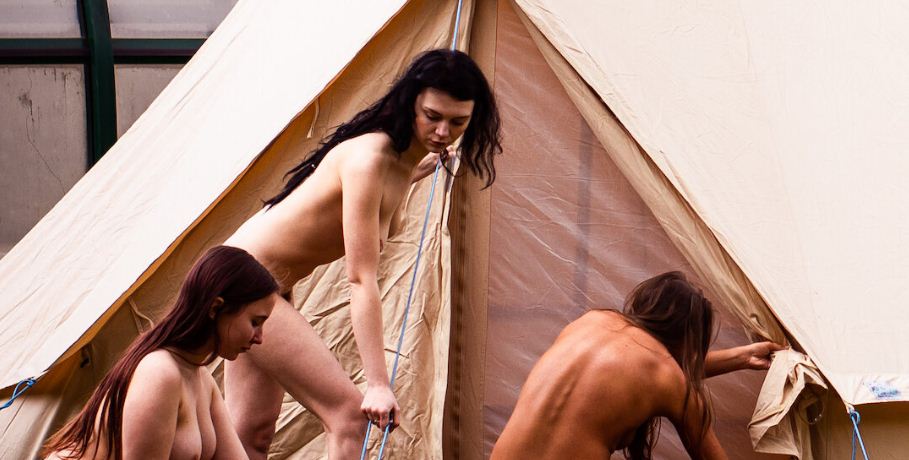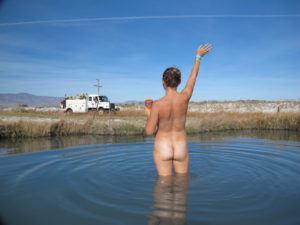
- Nudist fun: Bodypaint with friends

Bodypainting is a great way for people of all ages – from toddlers on up – to get naked and have lots of good, clean fun. Better yet, it can be practiced anywhere from private backyards to swank naturist resorts. Artistic talent may give more aesthetically pleasing results, but isn’t important for enjoying the application of (washable) paint to bare skin. It’s a way to “paint nudes” – without needing any artificial canvas. Even better, those who paint others need not be naturists themselves, although they mustn’t be afraid of nudity. However, they might discover a temptation to get naked themselves. Naturism Girl shows in a very brief video that “Just being naked on the beach is amazing by itself. But if you are looking for more fun activities, bodypainting can be a great choice.” - Why being a nudist is way better than not being one
Many of these points are well-known to naturists, but the list itself is extensive. It probably contains at least a few points you may not have thought of, so one or more could come in handy when explaining to others why you like being naked. There are about 50 separate points in the list. Here are some of my favorites:- It promotes family togetherness.
- Water and being naked go hand in hand.
- We humans feel more of a part of nature like we should.
- It’s so much fun, and more fun than being clothed.
- It’s hard to be naked and sad.
- It’s carefree, like in childhood and the summer.
- It means all of us get to be ourselves.
- 9 Common Myths about Naturism that are WRONG
I covered the general topic of most of the common misconceptions about naturism and social nudity here in some detail. Most of the issues could be of concern to anyone who enjoys nudity either at clothing-optional beaches or naturist clubs and resorts. And also nudity at home unless entirely in secret.The account referenced in the title above deals mainly with issues of concern to people thinking about visiting naturist clubs and resorts, as well as clothing-optional beaches to a slight extent. It hardly touches on issues of possible concern to home naturists.
Below are capsule summaries of why most of the concerns mentioned are based on “myths” about naturism – albeit a few that have some basis in the real world. As far as fears about visiting naturist clubs and resorts are concerned, there’s a very simple solution in many cases. Just read carefully the website of a specific club or resort to learn about their policies and find out what is or isn’t considered acceptable behavior. If the information is sparse or ambiguous, simply call the place before going there to clear things up. In addition, there’s often information available at sites like Tripadvisor and Yelp.
It’s more difficult to get information about clothing-optional beaches, which seldom have websites, although there may be online reviews for some of the popular ones. In this case, a personal visit or two may be the best or only way to learn about the place. The main concerns would be about legal issues and the general nature of regular visitors.
So here are brief summaries about concerns discussed in the article:
- You might end up at a sex club. Response: Real naturist clubs and resorts have nothing in common with “sex clubs”, except for the presence of nudity. It’s almost always possible to identify real naturist clubs by reading the rules stated on the website. If any doubt remains, just call the place and ask what’s allowed and what isn’t.
- Naturist places are full of voyeurs. Response: Real naturist clubs do not tolerate people making others uncomfortable by staring. Reporting any occurrences to the management should result in the problem being handled quickly. Naturists at popular clothing-optional beaches generally make voyeurs feel quite unwelcome.
- Naturists only camp. Response: Not true. If you don’t care for camping, before going read on the club’s website about what accommodations are available, and call ahead to make a reservation for the type of accommodation you would consider suitable.
- Naturists are hippies. Response: Not true. Many different types of people visit most naturist places. A few may have been “hippies” in their youth – 40 or more years ago. You might even enjoy meeting some of them.
- Naturism is expensive. Response: There are many different types of naturist clubs and resorts, and each has its own range of facilities. Call ahead to check whether the prices fit your budget. There are also many “non-landed” clubs that meet at private homes, sometimes go as a group to naturist places, and have very reasonable membership fees.
- You need a perfect body to become a naturist. Response: Not true. No legitimate naturist club discriminates on the basis of physical appearance. You’re likely to see a wide variety of body types. At first, you may need a little time to feel comfortable being naked, but most people adjust quickly. Being naked at home more often before visiting a beach or club should help.
- Naturism is for old people. Response: Usually false. There are various reasons younger people often aren’t represented in proportion to their percentage of the population – lack of free time, for example. Myths like some discussed here are another reason. Everyone, regardless of age, is made to feel welcome if real naturism is what they’re looking for.
- You have to be naked 24/7. Response: Not true. At all but a few naturist places these days, nudity is not required, except around swimming pools and spas. First-timers can delay undressing until they become comfortable. To be clear about the rules, call ahead before going.
- Children don’t belong at naturist places. Response: Usually false. Seeing adult nudity is not harmful to children. There are a few naturist resorts that are “for adults only”. This may be because adult visitors want to enjoy a brief time free of childcare responsibilities – rather than open sexual activity. Call ahead to verify that visitors under 21 are welcome, and if so they’ll be very safe as long as they have age-appropriate supervision.
- History of Naturism in Ireland

There was a story revealing that Ireland is a great place for naturists – back here: Naturism in Ireland is Alive and Well. Now there’s a sequel discussed in the article linked above. It’s an interview with the current president of the Irish Naturist Association, Pat Gallagher (how much more Irish could someone with that name possibly be?).Regarding the INA’s founding, he says, “these original members met while on holiday in Corsica and decided to form an association in Ireland when they returned home from this no doubt naturist vacation. Later INA committee meetings took place in a pub which was owned by one of the original committee’s members, and most original member meetups were in each other’s homes.” So the earliest members were home naturists to begin with, and the founders got inspiration, no doubt, from French naturists in Corsica.
There are many other interesting details in the article, which are instructive for how to successfully promote naturism in a country the size of Ireland, which has a population of around 6.6 million. That’s about the population of a mid-size U. S. state like Indiana or Tennessee. In this regard, Gallagher has an interesting comment:
“Lessons learned from other naturist federations as to how they made naturism more acceptable in their countries, gave us and continue to give us ideas as to how we can promote naturism in Ireland. However, I still think the International Naturist Federation (INF-FNI) has a lot more to do to make naturism more acceptable everywhere. I believe that this organisation should not leave it to individual countries to fight government policies in relation to naturism. ”In the U. S., the two national naturist organizations (AANR and TNS) correspond roughly to the INF. These two have done very little (if anything) to promote statewide naturist organization in individual states. There really are no statewide organizations of much consequence in any of the 50 states. Having such organizations is important for the purpose of lobbying individual state legislatures to make much-needed improvements to the legal climate for naturism in each state.
That task is left mainly (if at all) to smaller local groups, which lack the clout, skills, personnel, and resources to have much influence in even the smallest states. In addition, there’s almost no capability of providing advice and resources to support establishment and operation of local naturist clubs and beaches. So it’s hardly surprising that most naturists in the U. S. are able to enjoy naturism only in their own homes or with small groups of friends. The organizational structure lying between local groups and the national organizations is mostly not there. (AANR does have 6 “regions” of roughly similar size, each of which corresponds to a population (if evenly divided) of about 55 million people – more than the population of California.)
- Bathing Suits Optional at This Public Pool in Spain
Here’s a brief article about the successful establishment of swimsuit-optional hours at another public pool in Spain. It begins:
“Bathing suits are optional at this public pool in Spain’s Madrid on Sunday as the municipal sports centre of Aluche wants to celebrate ‘No swimsuit day.’ The swimsuit will only be optional in the morning shift and not in the afternoon shift (the two schedules created due to the Covid-19 pandemic) to celebrate this initiative launched in collaboration with the Spanish Naturism Federation.”In Spanish, the organization’s name is Federación Española de Naturismo. Thanks to the efforts of that group, clothing-optional hours have also been established at other public and privately-operated pools in Madrid. Unfortunately, based on this article, it seems that the clothing-optional hours were for only one specific day. Nevertheless, as in Ireland, this illustrates what can be accomplished for naturism by a national naturist organization.
- Swimsuit optional: the spontaneous, liberating joy of skinny-dipping
Most of this will seem quite familiar to naturists who’ve ventured outside of a naturist park or resort to enjoy nudity in nature. But it’s still refreshing to hear it said from a person who doesn’t especially identify as a naturist.According to the article’s sub-heading, “Like her granny before her, Rosie Green has plunged into sun-warmed seas, freezing lakes, moonlit rivers – all completely naked. She reveals here the spontaneous, liberating joy of skinny-dipping.”
The article, written by Rosie, begins:
“ My grandmother loved getting naked. Not when grocery shopping or gardening; she wasn’t some kind of eccentric or deviant. In fact, the only kinks she had were in her garden hose. But she did love skinny-dipping. When confronted with a pond, lake, river or pool she couldn’t wait to disrobe.… I’ve inherited her love of skinny-dipping. On my first Teletext-booked holiday with friends we ran stark naked into the Mediterranean. When we emerged, we had gained a welcoming committee and lost our clothes, but that didn’t put me off. I’ve plunged into freezing lakes, climbed over fences to swim in hotel pools and splashed in rivers at moonlight. All naked.”
Apart from the influence of her grandmother, how does Rosie explain her delight in skinny-dipping? She cites a number of factors, including teenage rebelliousness. “It unearths a little of the 18-year-old me. Which, I suspect, is what makes my teenagers so completely mortified about me doing it. There’s plenty of eye-rolling and indignation as well as threats of disowning me. But I don’t care what my kids say because skinny-dipping feels spontaneous, joyous, freeing, brave, exhilarating… and sensual.”
Naturists often explain their love of being naked as, simply, “because it feels so good”. This is generally not easy for non-naturists to understand. But as Rosie explains, it’s a complex feeling. There are several different aspects to it, each of which is reasonable and understandable.
Rosie goes on at some length with ideas of a psychologist, Fiona Murden. Like Murden, Rosie finds the appeal of being naked – skinny-dipping – is related to being immersed in water. “The silken water’s caress and the bonding laughter with my friends is balm for the body and mind,” she writes. But only water of a reasonable temperature. “For me, skinny-dipping is a high-summer activity. I know some brave souls throw themselves into icy pools in January, but not me. In my world it is forever linked with languid, lazy hot days.”
Most naturists probably think there’s more to nudity than that. Many, of course, are quite happy being clothesfree in the warmth and privacy of their home, with or without the company of others who also enjoy being naked. Naturism has different yet legitimate meanings for different people.
- All The U.S. Cities & States Where You Can (Legally) Celebrate National Nude Day
Here’s one more article about the quasi-holiday “National Nude Day”, which was written about previously here and here. The article lists 6 U. S. cities and states where, supposedly, it’s legal to be naked in public: Seattle (WA), Oregon, Austin (TX), New York (NY), Philadelphia (PA), and Florida.Don’t rely too heavily on this advice, however. In all cases, nudity must not be “lewd” or “offensive” to others. Those are fairly subjective standards. And where States are concerned, there may be local ordinances that could be much more restrictive about nudity. Unlike countries, such as England and Ireland, where there’s a uniform standard for the whole country, at least in theory, the places listed here may not be tolerant of nudity just anywhere, even if it isn’t “lewd”. The situation in Florida is actually a little murky. For instance, nudity may be OK on private property, even if it’s visible from other property. But local law enforcement might cite some other violation, such as “disorderly conduct” if they feel like it.
Also, there are a couple of notable omissions. One is California, where, as in Oregon, non-lewd nudity is technically legal anywhere (by a court decision), provided there aren’t stricter local ordinances. Also, on Federal land, such as National Forests, nudity may be allowed (or not) depending on local regulations.
- Fullers Mill Gardens to host naked visit for naturists

Here’s yet another example of how naturism is regarded in sensible countries like England (at least in this respect) as a perfectly acceptable (albeit rare) personal interest – quite “normal”, in other words. So setting aside a specific time for people to nakedly enjoy a lovely botanic garden isn’t controversial. It took place in August and was only for a few hours on one day. But it still attracted favorable attention to the place, and over half the ticket price was donated to a charity. Some might dismiss something like this as a typical British “eccentricity”. But so what? It’s better than the clotheist conformity prevalent in most other countries.Another news article about this event: Back to nature – naked event at botanic gardens


































